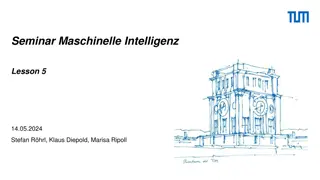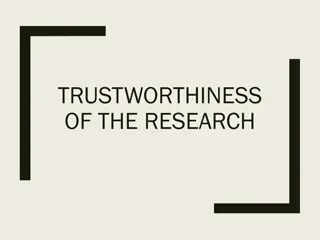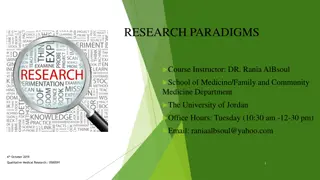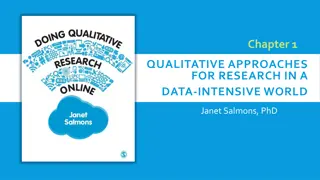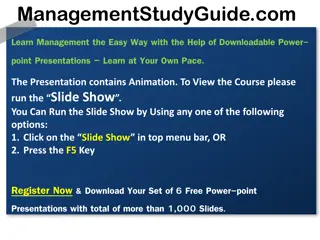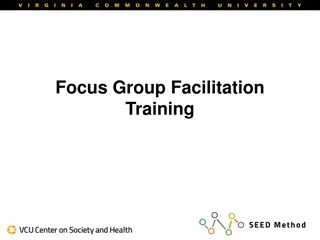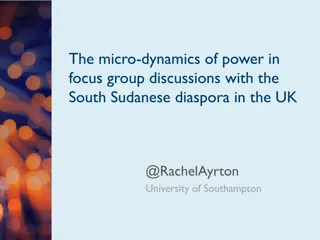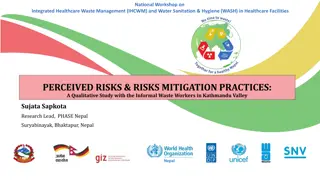Understanding Focus Group Discussions in Qualitative Research
Focus Group Discussion (FGD) is a qualitative research method that involves a structured discussion among a group of participants led by a skilled moderator. The aim is to gather insights, opinions, and consensus on a specific topic. FGDs facilitate interaction, generate new ideas, and offer deeper insights not easily obtained through individual interviews. This method involves designing specific objectives, selecting participants based on criteria like age and gender, and appointing a facilitator and note-taker to guide and document discussions, respectively.
Download Presentation

Please find below an Image/Link to download the presentation.
The content on the website is provided AS IS for your information and personal use only. It may not be sold, licensed, or shared on other websites without obtaining consent from the author. Download presentation by click this link. If you encounter any issues during the download, it is possible that the publisher has removed the file from their server.
E N D
Presentation Transcript
Focus Group Discussion Dr Muhammad Ibrar
Meaning & Definition A Focus Group Discussion (or FGD) is a qualitative research method in the social sciences, with a particular emphasis and application in the developmental program evaluation area. FGDs are a predetermined interview led by a skilled moderator. The moderator asks broad responses and generate discussion among the participants. The moderator s goal is to generate the maximum amount of discussion and opinions within a given time period. semi-structured questions to draw
Definition A focus group discussion is a structured discussion used to information (qualitative data - insight) from a group of people about a particular topic. The purpose of a focus group is to collect information about people s opinions, beliefs, attitudes, perceptions, consensus or make a decision. obtain in-depth not to come to
Contd. The aim of the FGD is to facilitate interaction and thereby produce, via snowballing of thoughts, deeper insights. FGDs provide information on a group/community level. The strength of an FGD is the forum it creates for discussion between participants, thus obtain new ideas and explanations, which would not have come up during an individual or a household interview.
FGDs Design 1. Specific objectives of FGDs: which themes will they be covering and for which purpose. 2. Location, number & timing of FGDs: a. Venue? b. Time? c. When? 3. Composition of FGDs: a. Participants selection, e.g. which different target groups will be covered? b. Type of FGD will be categorized according to Age, Gender and diversity criteria
Facilitator An FGD facilitator, who is responsible for introducing the FGD to all participants, guiding the discussions, facilitating ensuring that the most important topics are covered considering the time available, and finally closing the discussion. participation,
Note Taker A note taker, who is responsible for capturing the discussion, and later on elaborating on the notes and turning them into an electronic version. A recording device can be used by the note-taker (not as replacement to the note taking, but as complementary), in which case, participants should always be informed and asked for permission.
Role of Facilitator a. Be neutral: Do not convey your own perceptions (neither directly nor indirectly though questions) and do not correct the informants, as there are no right or wrong answers. Even if someone says something which factually is wrong, leave it up to the group to correct, if they see it fit (factually wrong data are also data).
Contd. b. Be patient: do not finish people s sentences and do not interrupt. Leave as much silence and pause as is needed for the group to think. c. Do not guess: ask for clarifications whenever needed, do not guess what was meant if you are not sure. d. Clarify terminology: make sure that all participants have a common understanding of any terms or phrases coming up.
Contd. e. Probe (Search): when necessary, ask participants to elaborate and encourage views by more people (e.g. could you better explain in more detail? Can you give us an example? Anyone sees things differently? Does anyone have a different experience to share?) f. Stay curious: after having facilitated the first many FGDs, do not presume you know what will be said in future discussions. That would delay capturing and pursuing new things coming up, and you will only document what you expect to hear.
Contd. g. Facilitate participation: attempt to include all participants in the questions to individuals, who are not talking, and mix away from others, who are too talkative, by involving the whole group again. h. Do no harm: keep in mind ethical consideration when bringing up sensitive topics. If a discussion is judged to be hurtful for some or will create problems after the FGD is finished, avoid further pursuing of the issue. discussion, e.g. direct
Contd. i. Coordinate with the note taker: make sure the pace of the discussion is aligned with the note taker; the discussion is not worth much if not documented properly. j. Guide the interpreter: in case you use an interpreter, make sure that the person is well informed on the methodology, the topics, the terminology and aim of the FGD, as well as interpretation guidelines.
ELEMENTS OF A GOOD FOCUS GROUP DISCUSSION The followings are the basic elements of a good focus group discussion: 1. Group size keep it small Focus groups are usually pretty small to allow participation from all members. One study says that the recommended number of people per group is usually six to ten but some groups go as high as fifteen.
Contd. 2. Time keep it short: Researchers generally agree on fixing a period of 1 to 2 hours. This time allows for discussion but also accounts for potential tiredness that can set in with longer sessions. 3. Location/set-up: A room, with comfortable chairs, in which people sitting around a table can talk and keep visual contact with each other is considered good enough to develop a discussion . To avoid negative or positive associations with a particular site, building, or location, however, neutral locations can be helpful.
Contd. 4. Group composition - staying focused: The main composition issue with focus groups is that the members characteristics that the research requires. So for at least one criterion the group is homogenous, but may not be in many other ways. Diversity in the group is desirable as extremely homogenous groups may produce unneeded discussion. have the defined
Contd. 5. Design good planning required: The good design will include not just attention to the framing of the questions but also to strategies and tools for triggering good discussions, such as using scenarios, case histories, visualization exercises and other methods. The design will also allow for time for check ins, ground rules, possible breaks, as well as time for the consent forms and other logistics. The design phase will also consider issues such as childcare, and food. If there are focus groups being conducted in multiple languages or if there will be translation, these issues are addressed in the design phase.
Contd. 6. Facilitation process: Focus group moderating requires skills and knowledge of the topic. There are processes in the planning/design that can aid facilitation but a good facilitator should be at least capable of creating a relaxes atmosphere in which people can freely talk . 7. Ethics Focus groups are a form of social science research and face the same ethical issues of most other social science methods. All participants must sign a consent form, and that form should be clear about the scope and intent of the project and the right of participants to withdraw. During the focus groups only first names should be used. While the confidentially by the research team should be assured, there is no way to control the confidentially by the participants. Participants should be encouraged to keep the content of the focus group confidential but there is no way to enforce this practice. It must be clear that participants cannot be guaranteed to have confidentially.
Contd. 8. Recording data: Focus groups are recorded in some way, and audio recording is usually considered less disturbing than video recording or another persons Sometimes a separate note-taker is used though a second person can act as a possible influence on participants. 9. After focus group: Data should be labeled with time, date and location of the focus group and compiled always according to the research design. direct observation .



